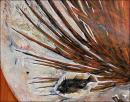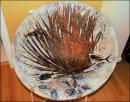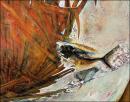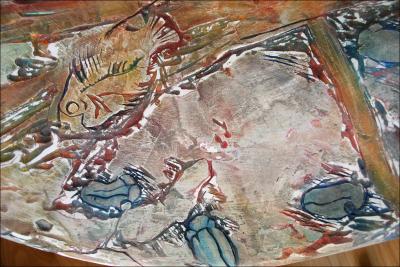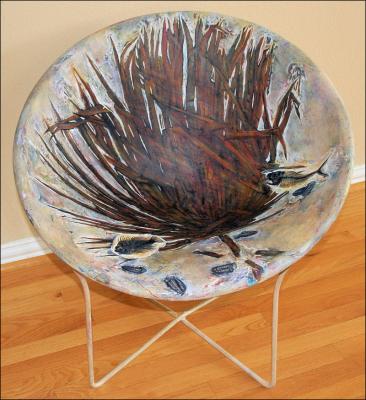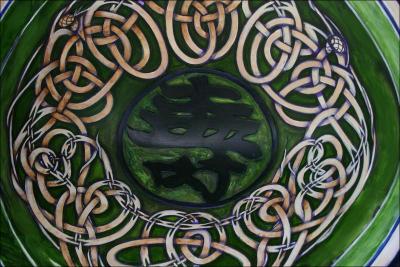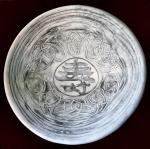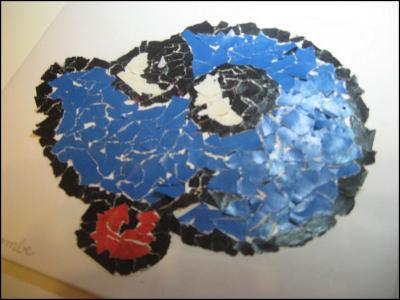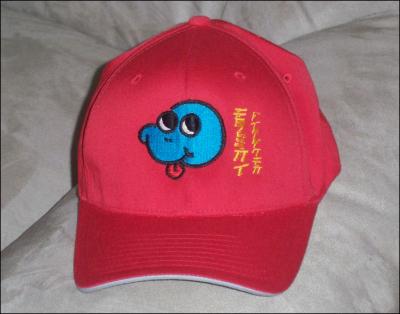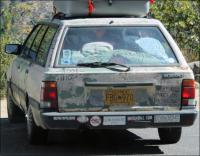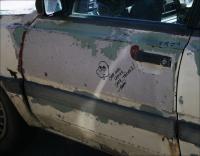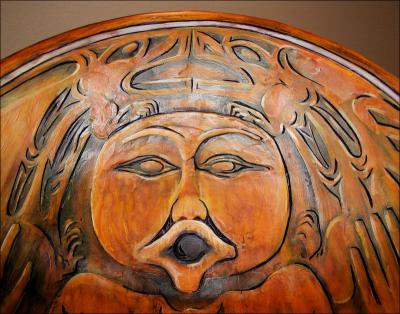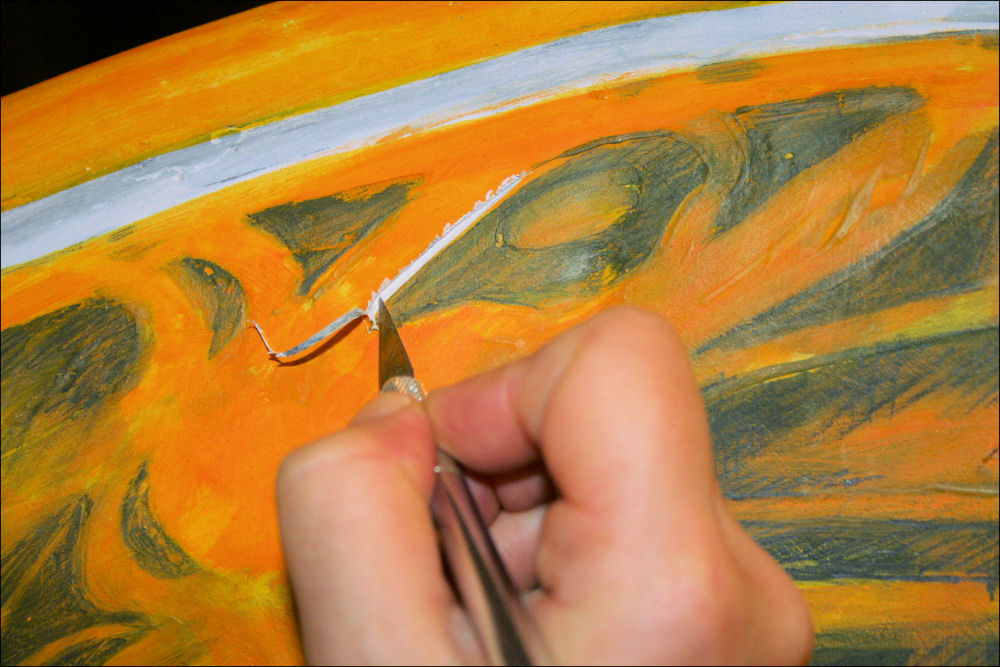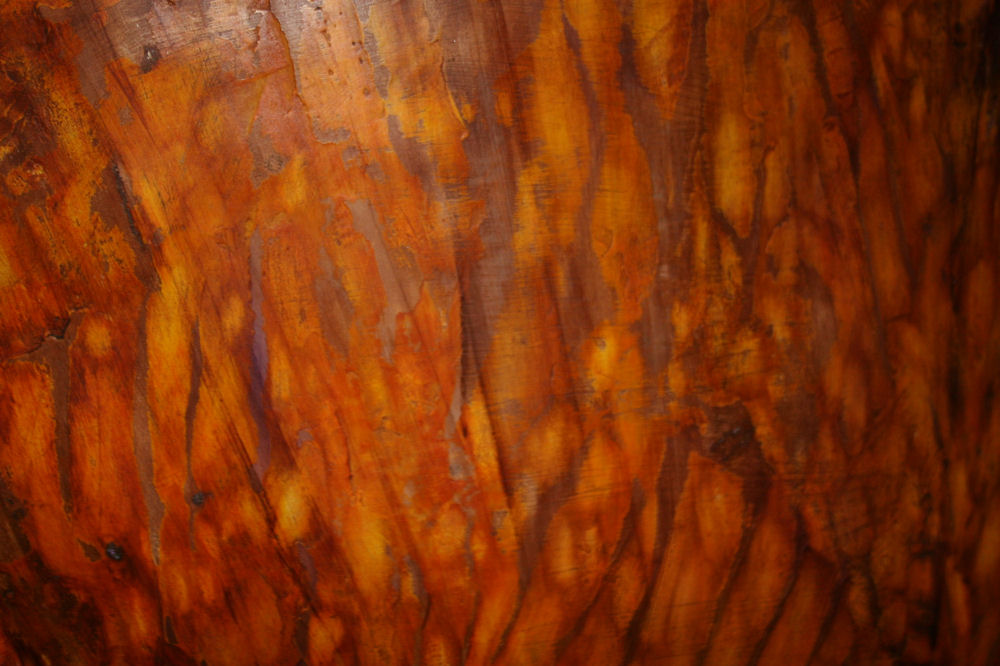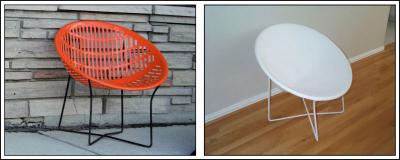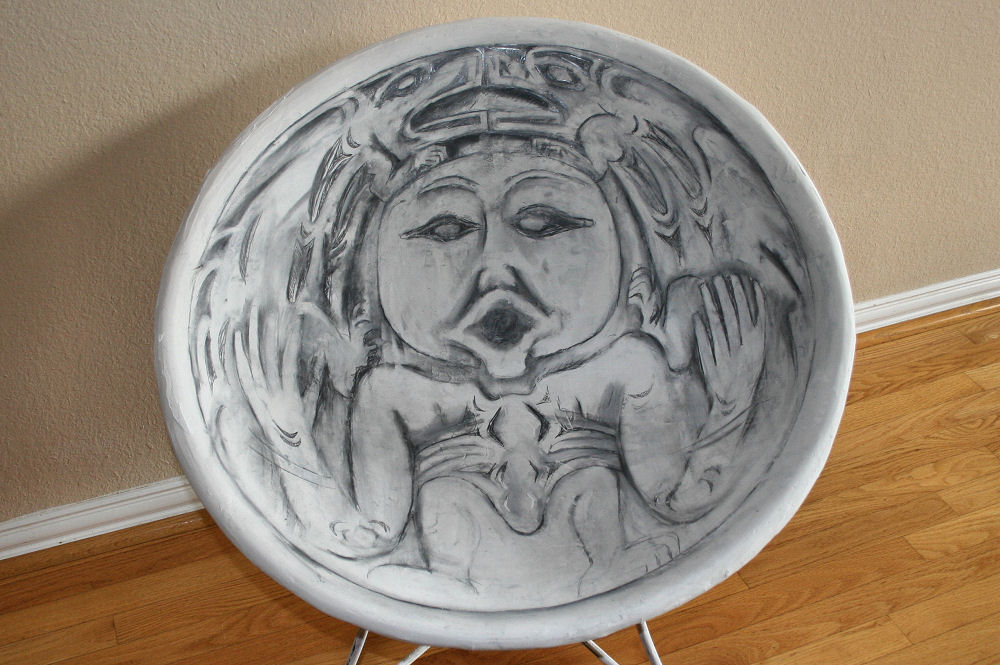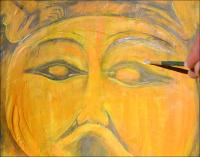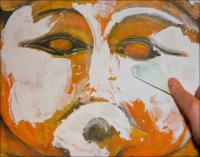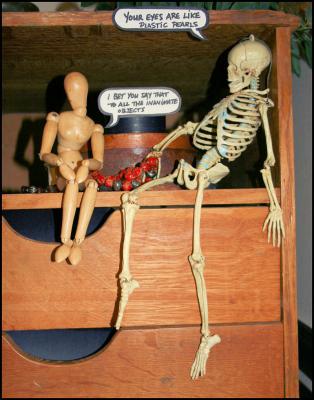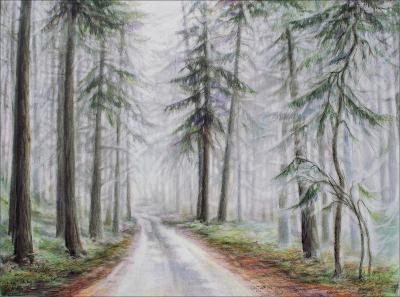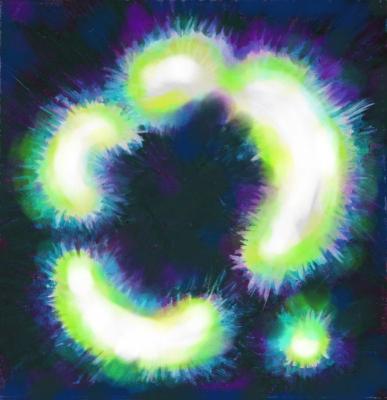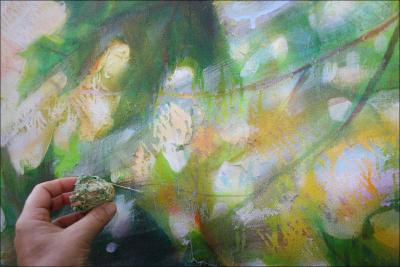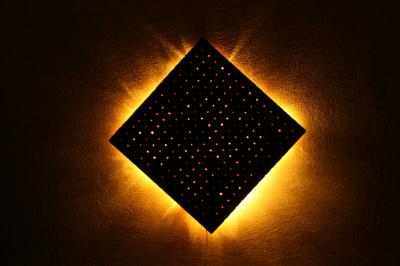mixed media
« Previous Entries Next Entries »Fossils Chair, Homage to The Earth – finished
Wednesday, April 22nd, 2009
January 12th: While sanding the wood for the Sumac Bushes Chair during coffee breaks, I have started the Fossil Chair, paying homage to the fact that without trees, all life on Earth would not be so prolific, and might not exist at all. Fish and Trilobites are carved into the plaster on the front surface of the chair as well. in this series.
January 13th: Lower detail of Fossil Chair, carved plaster, acrylic paint inlay, sanded. In progress. Trilobites will have painted detail.
Jan. 14th and Jan. 24th updates, below: front details, work in progress on back/underside of the chair. After this stage, all details will continue to be refined with more carving and layers of acrylics. Haven’t done many details on the trilobites yet. The colors in the palm leaf still are too vibrant for a fossil, but are a perfect underlying color because it shows through when layers of blues and black are wiped away with a cloth.
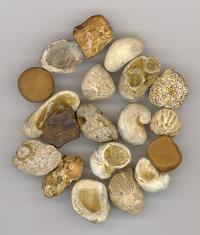 Fossils Chair, Homage to The Earth, started in January and finished today, except for refining the bark fossil patterns on the back/underside. 29 x 29 x 29 inches refurbished vintage chair, canvas strips, plaster, carved, acrylics, varnish, waxed.
Fossils Chair, Homage to The Earth, started in January and finished today, except for refining the bark fossil patterns on the back/underside. 29 x 29 x 29 inches refurbished vintage chair, canvas strips, plaster, carved, acrylics, varnish, waxed.
The back of this chair has authentic 225 – 345-million-year-old fossilized clam shells embedded around the circumference. Next, the Encyclopedia Britannica listing. The fossils were found in a mixture of playground pebbles in Dallas, TX.
The Cycad leaf fossil replica original was discovered in a Wyoming, USA river basin. Portrayed on the front of the chair is the fossil of a Cycad, the first of palm-like trees that grew about 50 million years ago in a Wyoming riverbed. The first trees on Earth were actually nothing more than woody stems standing in and absorbing nutrients from water. Patterns of fossilized Paleozoic Lepidodendron bark- leaf scars are painted on the underside of the chair. Lepidodendron were a primitive species of the very first trees on earth, reaching heights of 130 feet (40 m) tall around 400 million years ago. Can we even relate to those numbers? That’s what I love about fossils – holding one and contemplating Earth’s timeline is mind-blowing.
| Progress details: | |||||
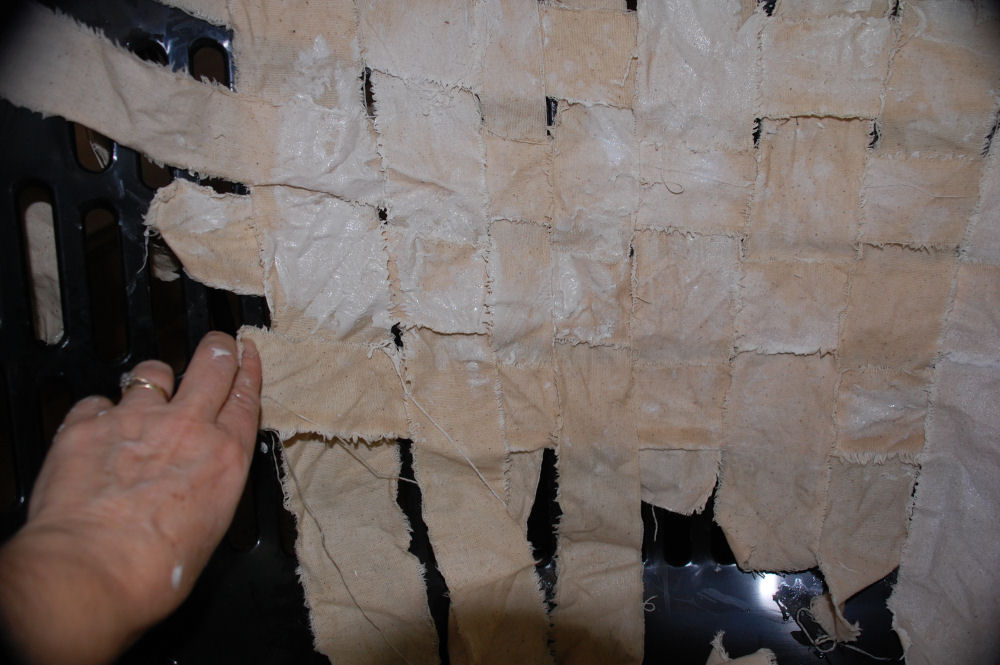 |
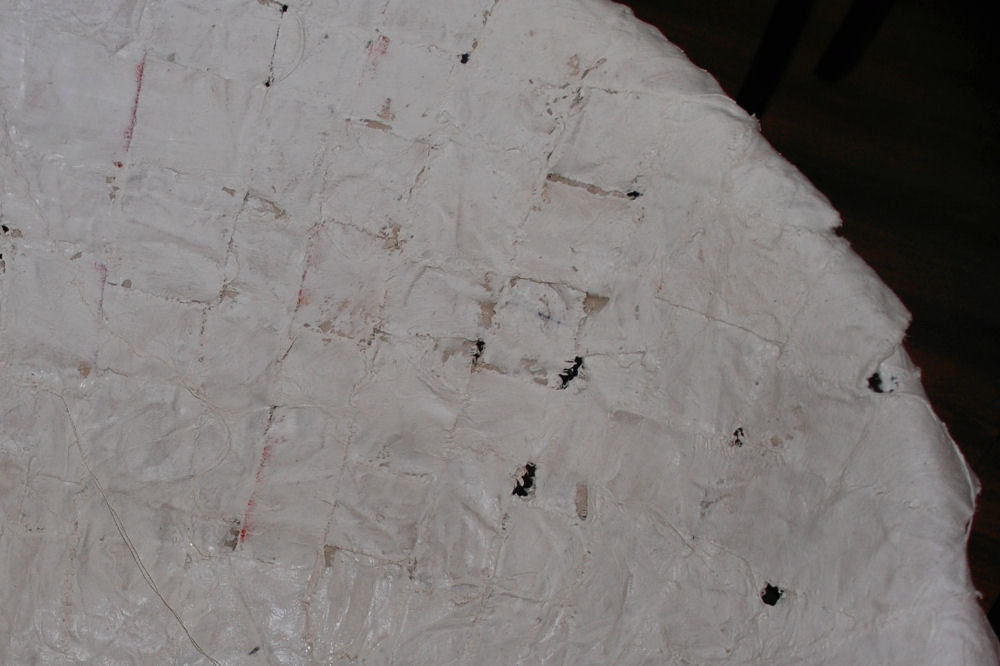 |
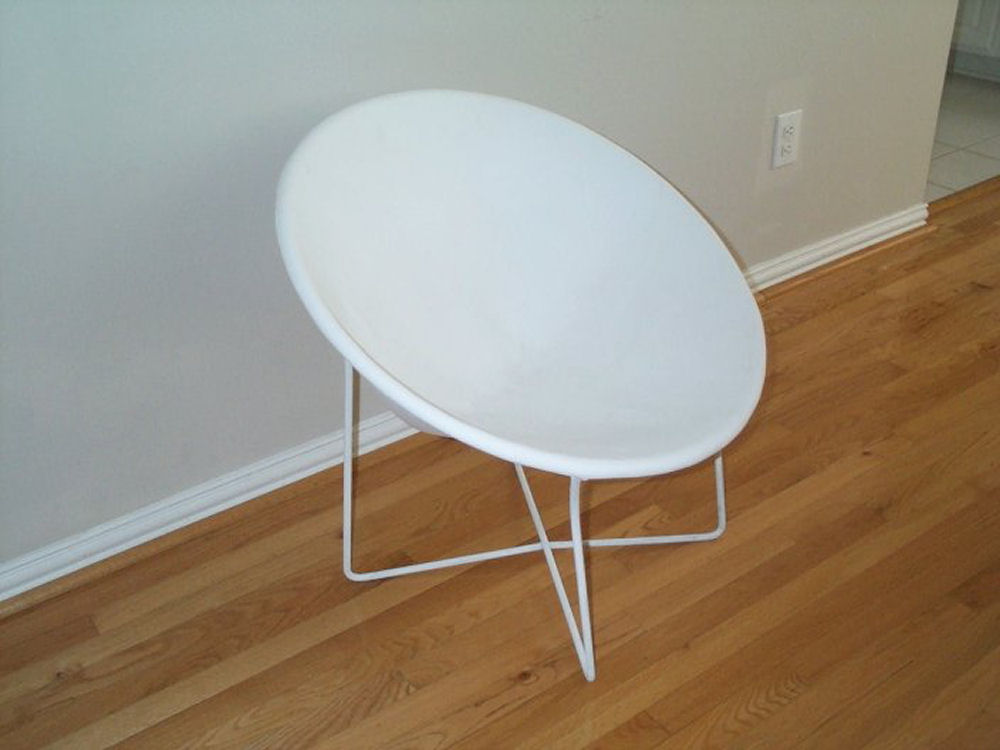 |
|||
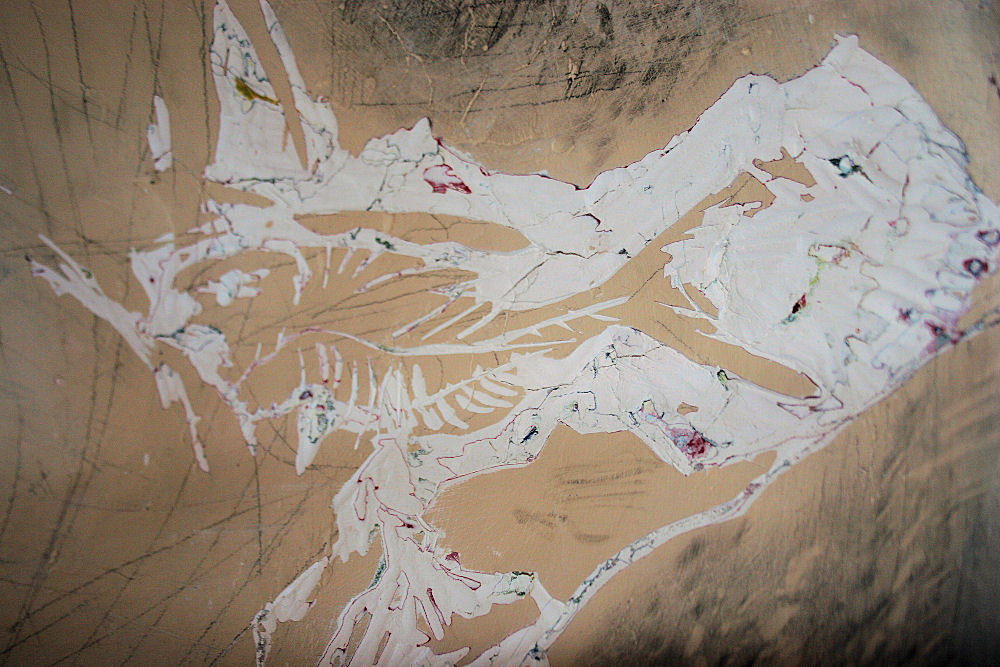 |
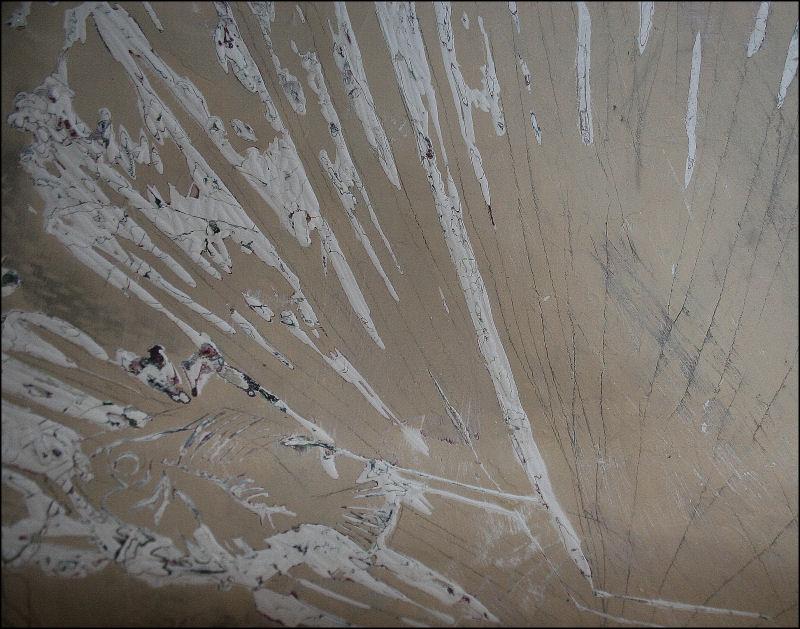 |
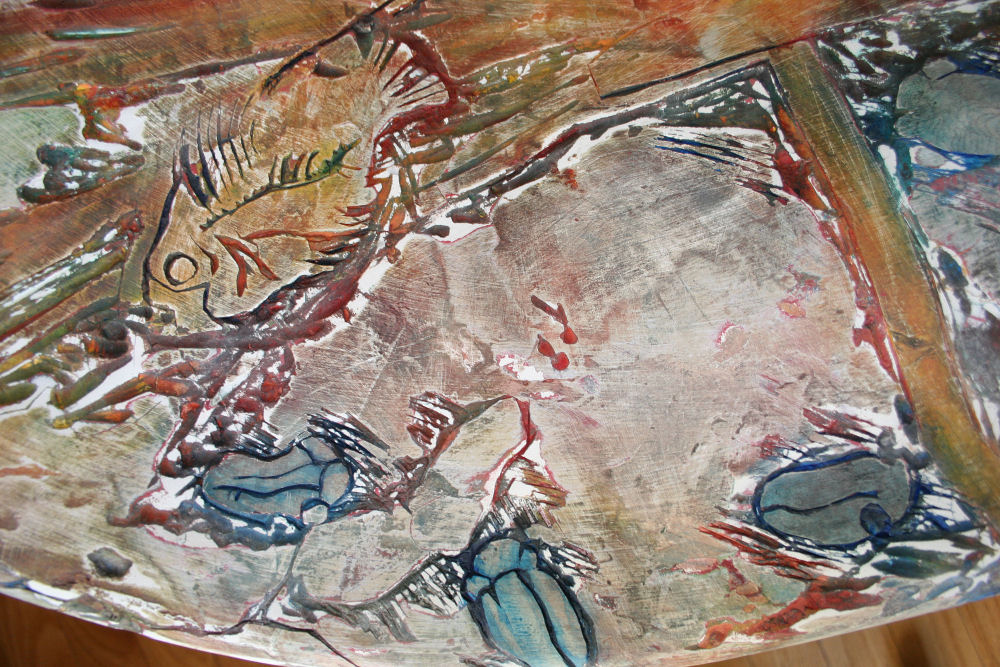 |
|||
| Finished details: | |||||
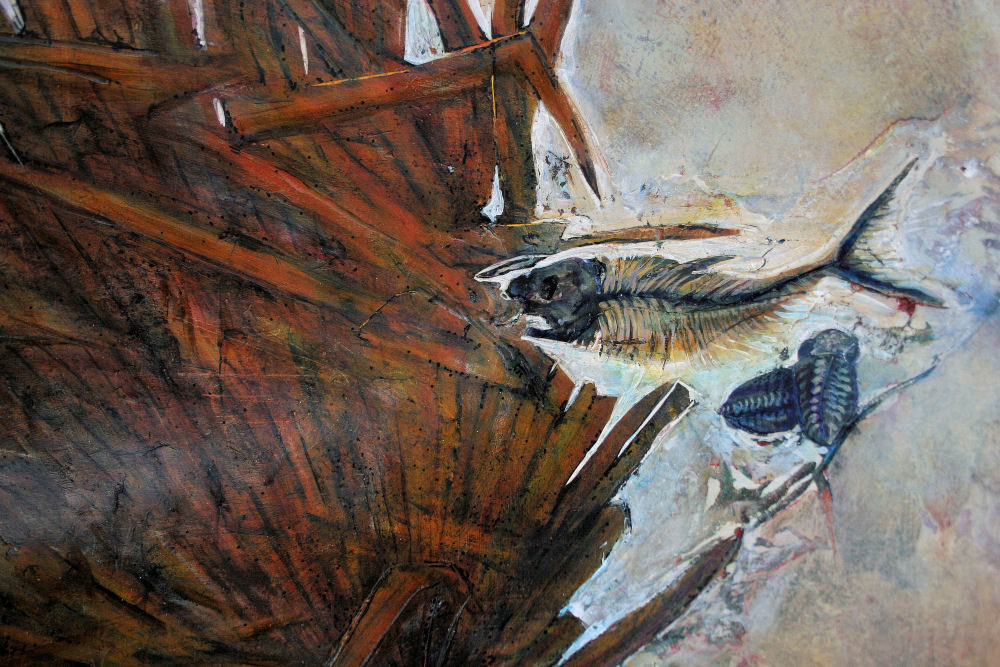 |
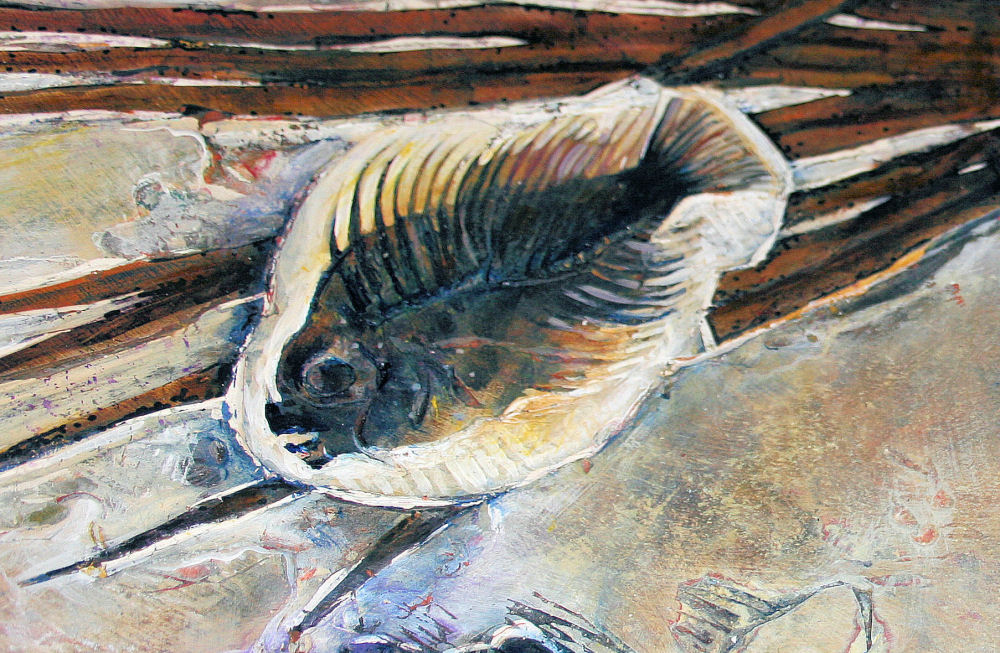 |
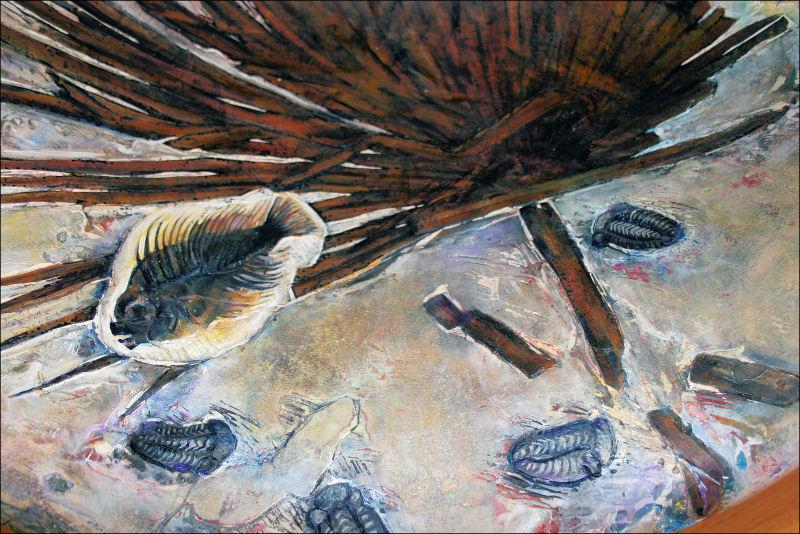 |
|||
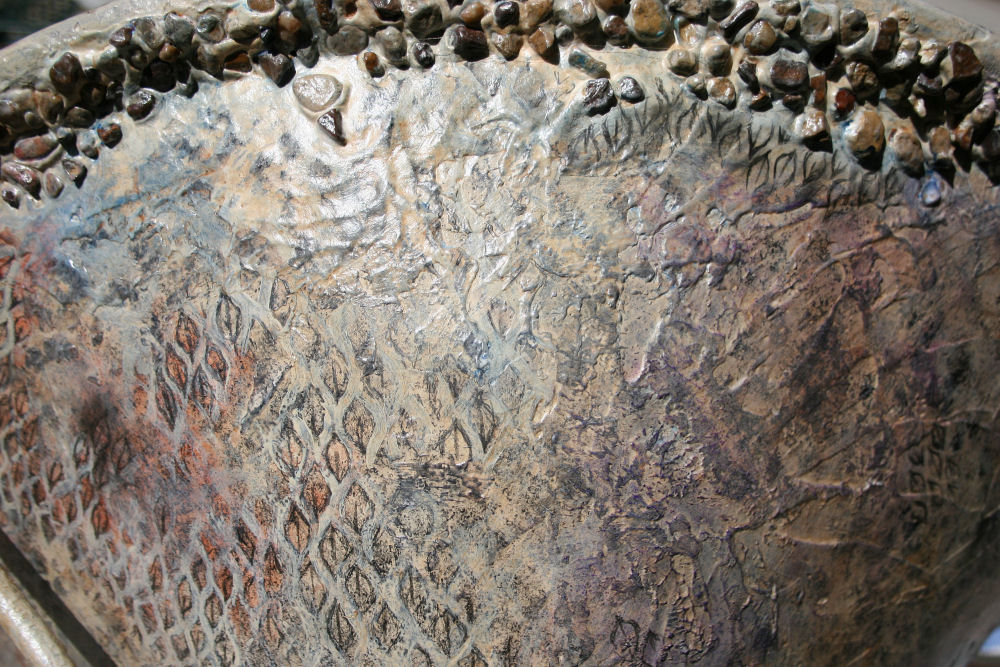 |
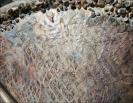 |
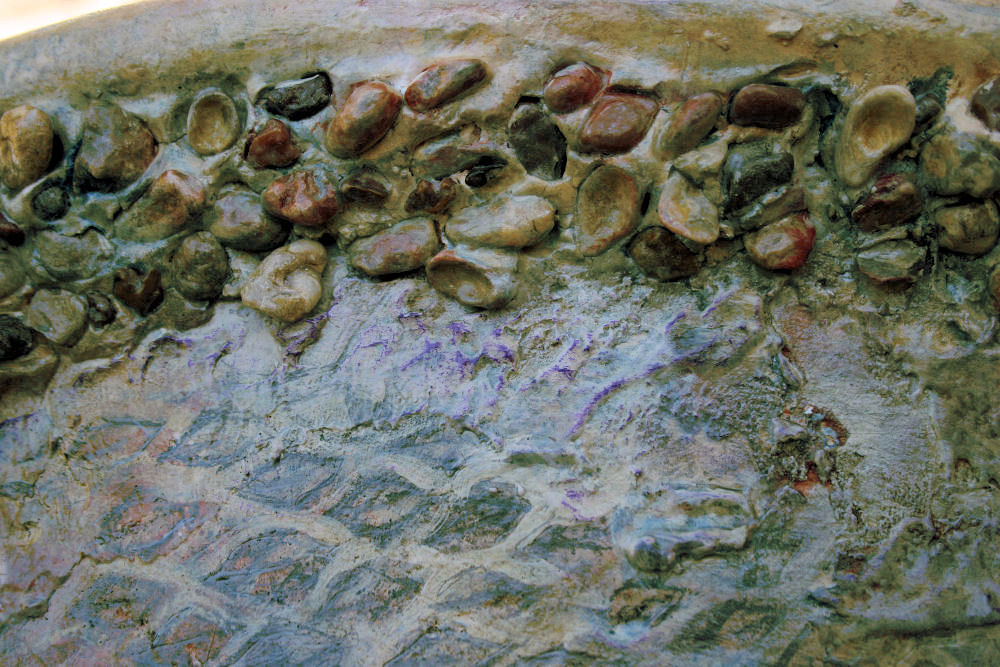 |
The Tree Of Life chair
Saturday, April 18th, 2009
April 18th, above: still in an extremely rough state, and still deciding about which colors to use and how. There must be much more plaster on the Salish chair, because this one is not carving as well. Only the Shou symbol will stand out carved..all else will be implied. Blue, purple and green are the new black! Actually that’s the old impressionist trick of course, but I also rarely use black if those 3 will do – they are much livelier and more interesting than flat black. The Yin-Yang/Aboriginal legend snakes have been eliminated because working them in color-wise was going to be a problem. The Celtic design was getting lost in too much else around it. I am anxious to find another chair because I really want to do one with Australian-inspired motifs and colors.
Post-dated note: Unfortunately, there is not enough room to show this for the premier of the Trees show in Raleigh. I’m mostly relieved that there is extra time in my schedule now for preparations, but this chair now needs to be set aside in light of the other priorities.
April 14th: 29H x 29W x 29D inches vintage chair, canvas strips, layers of sanded plaster.
The design incorporates a few esoteric concepts common to many world cultures: Overall is the idea of the Tree of Life and the theory of As above, So below, represented by branches and roots. Symbolic of longevity along with the pine tree, and central to the design is the Japanese character, Shou. The branches and roots of the pine tree are interwoven in the classic Celtic style, inspired by designs in the Book of Kells, gospel manuscripts that were illustrated by Irish monks around the year 800 A.D., common era. Two snakes drawn in the Yin-Yang placement represent Australian Aboriginal legends; the Rainbow Snake is their most important sacred symbol, believed to be the creator of all things. Christian biblical literature it is the snake who gives the apple from the Tree of Knowledge to Eve. There are more, but the rest you may like to discover yourself!
There is still plenty of intricate work to do with the roots – this’ll be fun! Drawing freehand is much better than casting the original drawing on with light and tracing it because each time it’s drawn, first with graphite, then marker, then many layers of paint, I become more familiar with the lines and the final outline will be steady and clean.
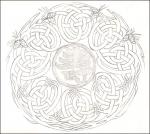 April 7, 2009: While studying some of the previous paintings that are still in progress, I sketched out my version of The Tree of Life, a preliminary drawing for the fourth refurbished vintage chair, and have also been layering and sanding the plaster in preparation for it. Colors planned are black, off-white and greens. The other chairs in this series are shown here.
April 7, 2009: While studying some of the previous paintings that are still in progress, I sketched out my version of The Tree of Life, a preliminary drawing for the fourth refurbished vintage chair, and have also been layering and sanding the plaster in preparation for it. Colors planned are black, off-white and greens. The other chairs in this series are shown here.
The Monte Files
Saturday, January 3rd, 2009
Post-dated January 11th, my niece Camille created this.
Post-dated January 28th, my son Adrian created this with his new industrial emboidery machine…good luck with your new biz Adrian!
 Who or what is Monte? (“Mon-tee”)
Who or what is Monte? (“Mon-tee”)
Borne out of inattentiveness in a grade six science class, I drew Monte everywhere on my friends’ notebooks, on everything I owned, even painted him on the back window of a friend’s car during the late ’70’s, which I have no photo of, unfortunately.  Monte has managed to come back to life every few years since then in some form or another. The cartoon head is originally blue and drawn along with different hand gestures, but the basic shape can morph into any figure simply by changing the eyes, shape of the head, adding ears or a nose or a suitable body.
Monte has managed to come back to life every few years since then in some form or another. The cartoon head is originally blue and drawn along with different hand gestures, but the basic shape can morph into any figure simply by changing the eyes, shape of the head, adding ears or a nose or a suitable body.
 The Monte Files were listed on my very first website (2003) with the invitation for you, whoever and wherever you are, despite your age or drawing capabilities, to send in your version of Monte or a character inspired by him, and add it to the collection. The Monte Files are back, listed as a permanent page on this website and the invitation stands.
The Monte Files were listed on my very first website (2003) with the invitation for you, whoever and wherever you are, despite your age or drawing capabilities, to send in your version of Monte or a character inspired by him, and add it to the collection. The Monte Files are back, listed as a permanent page on this website and the invitation stands. 
Your character doesn’t even have to resemble Monte at all, and can be created using whatever media you wish. Scan him, trace him, shred him to bits then reassemble him, make a collage with magazine clippings, write a quip or add hand gestures…no rules except be kind and have fun with it; Monte’s up for anything….
 Children, adults, artists or not, or if you have a website of your own that you’d like to promote in The Monte Files then send a jpeg image of your version of Monte, or a character inspired by him, along with any information you wish to share to nikki_coulombe@hotmail.com. I have no knowledge of how to, nor a desire to use your information in an unethical way, so you have no worries about that.
Children, adults, artists or not, or if you have a website of your own that you’d like to promote in The Monte Files then send a jpeg image of your version of Monte, or a character inspired by him, along with any information you wish to share to nikki_coulombe@hotmail.com. I have no knowledge of how to, nor a desire to use your information in an unethical way, so you have no worries about that.
When we were in California recently we met some ladies at a rest stop who were driving to New York City from Alaska in a beat up old car. Friends, and people they met along the way signed their car. Monte travels!
Salish Spindle Whorl Chair finished
Saturday, December 20th, 2008
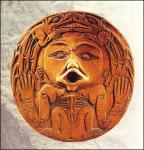 About the chairs: Art on Art on Art – A Tribute to Creativity
About the chairs: Art on Art on Art – A Tribute to Creativity
Each functional, comfortable 29 x 29 x 29 inch replica of ancient Art or artifact re-utilizes vintage plastic lawn chairs that were considered Art during the 1960’s. The original structures, damaged or unusable were refurbished by a process of weaving canvas strips along with white glue paper-mache style over the entire plastic top and bottom, and multiple layers of drywall compound sanded in between coats. Designs are drawn with graphite, painted with acrylics and a few coats of varnish for durability, then waxed to finish and enrich the colors. Two more Solaire chairs and other styles of chairs are in various stages of completion yet to be embellished with historic Art themes from other cultures. Other styles of chairs are also in progress.
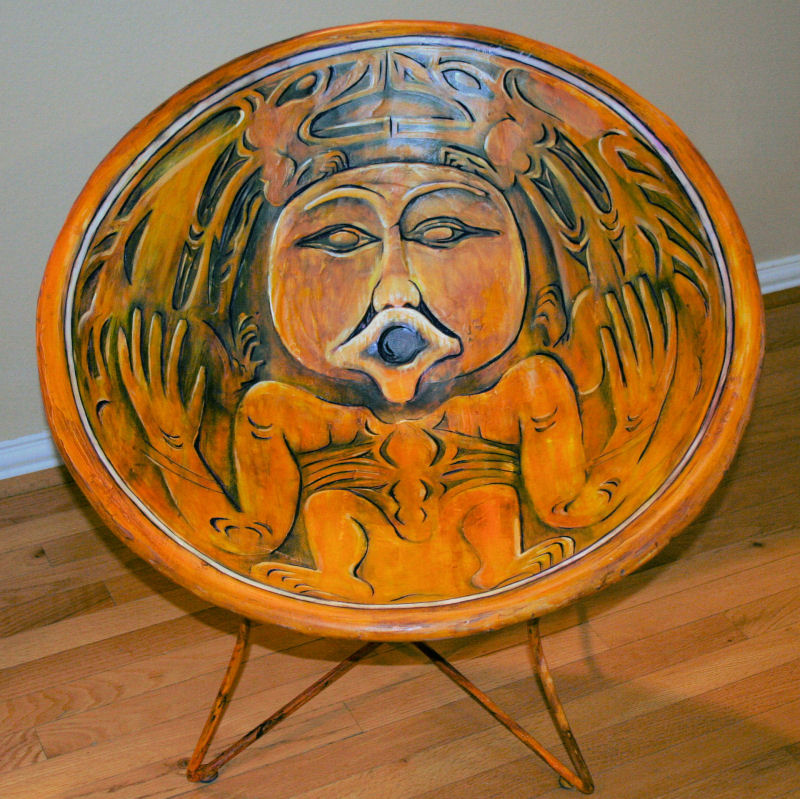 The skeletal structure of these chairs, called Solaire chairs, were manufactured during the 1960s and 1980s. Art in their own day, these particular ones were unusable; in poor condition they were bound for the landfill sight. Originals designed by Fabiano and Panzini, a French Canadian team, the Solaire chairs are now collectors items, some selling for $500.
The skeletal structure of these chairs, called Solaire chairs, were manufactured during the 1960s and 1980s. Art in their own day, these particular ones were unusable; in poor condition they were bound for the landfill sight. Originals designed by Fabiano and Panzini, a French Canadian team, the Solaire chairs are now collectors items, some selling for $500.
The first chair to be up-cycled was a large replica of a Mayan bowl. The Mayan culture (Mexico, Guatemala, Belize and parts of Honduras, 900 B.C. – 900 A.D. Common Era) developed a very complex written language using pictographs. Many of these were facial expressions and hand gestures. The bowl displays the birth of the Maize God, and along the top edge the name of the bowl’s owner is written, as well as possibly what it was used for.
Salish Carved Wood Whorl
 Whorls are weights that stabilize used for spinning yarn. The yarn in this case would have been wound just above the whorl. Spinning yarn and weaving fabric are some of humankind’s oldest technology. Left: example of a spindle with whorl, Eve Spinning Illuminated Manuscript c. 1170 A.D.
Whorls are weights that stabilize used for spinning yarn. The yarn in this case would have been wound just above the whorl. Spinning yarn and weaving fabric are some of humankind’s oldest technology. Left: example of a spindle with whorl, Eve Spinning Illuminated Manuscript c. 1170 A.D.
Historically everywhere wood has been used for tools, utensils and everyday items, they were often carved. The original spindle whorl that was the inspiration for this chair was used by a Salish Northwest Pacific coast community living south and east of Vancouver Island. Here a central human figure holds two otters. A Kwakiutl (also living in Vancouver Island territory) prayer to a Cedar tree prayer was very much a part of the inspiration for this chair. It reads: “Look at me friend! I come to ask you for your dress, since there is nothing you cannot be used for. I come to beg you for this, Long-life maker”.
December 18th: Finishing details, further definition with acrylics and two coats of varnish, waxed. Decided against the decoupage of the Kwakiutl prayer to a Cedar tree because it does not look as good as hoped. December 16th: Carved the plaster in areas then inlaying purple for contrast rather than black. Purple glazes also make yellows much richer.
The back and under-side of the chair is painted to look carved. The undercoat of yellows shines through succeeding layers, and carved wood textures are created with varnish leaving raised brushstrokes, and am trying whatever else I can think of to make it look like wood! More modeling with plaster and light sanding, then redrawing with graphite, and the design is continually adjusted.
New chair started: Salish Wooden Whorl
Sunday, December 14th, 2008
This functional replica of a Salish Carved Wood Whorl re-utilizes a 1960’s plastic lawn chair, 29H x 29W x 29D inches that was considered Art in its own day. The refurbished chair has woven canvas strips and white glue applied paper-mache style over the entire plastic top and bottom. Multiple layers of wall plaster are sanded in between coats. The design is sketched with graphite then painted with acrylics, and drawing is continually adjusted as layering of materials continues.This is the second chair of four in the historic Art-themed series. The other two chairs are in the earlier stages of progress.
A Studio Affair
Tuesday, October 28th, 2008
“Your eyes are like plastic pearls”
“I bet you say that to all the inanimate objects”
The romance began last year.
Salt Spring Island Fog
Monday, July 14th, 2008
Salt Spring Island Fog, 18H x 24W inches graphite, eraser, dry pastels, colored pencils on paper, burnt umber frame size 29H x 35W x 3D inches, accepted for the Visual Arts Society of Texas 2009 Calendar. All accepted original works will be displayed. Meet the Artists and purchase a signed calendar (or more!) on November- December, 2008 at The Chestnut Tree in Denton, TX.
Post-dated Note: Article published in the Denton Record Chronicle, Entertainment section February 8th, 2009
Seeing spots
Wednesday, May 28th, 2008
Seeing Spots, 12 x 12 inches oil pastels on paper, scanned and reworked with a digital pen. The sun is so strong today, I was outside for only about ten minutes then came indoors and this is all I could see in front of me.
Sun Shower 04
Friday, May 23rd, 2008
May 30th: Today I’m starting to remove miles of rubberized masking medium. It’s so exciting to unravel the results; they look a little like Batik, where wax or resist is applied then removed.
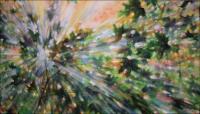 Sunshower 04, 49 x 85 x 3 inches acrylics on canvas. 29th: Starting to build thin layers of acrylics, gel medium and water. As previously posted, when painting is all finished I plan to remove all of the masking medium and reveal the original colors underneath. Paint catching on the textured surface gives the look of 3D raindrops…very interesting, and in retrospect I don’t know why it wasn’t obvious that this would occur.
Sunshower 04, 49 x 85 x 3 inches acrylics on canvas. 29th: Starting to build thin layers of acrylics, gel medium and water. As previously posted, when painting is all finished I plan to remove all of the masking medium and reveal the original colors underneath. Paint catching on the textured surface gives the look of 3D raindrops…very interesting, and in retrospect I don’t know why it wasn’t obvious that this would occur.
I was mostly thinking ahead about the atmosphere and negative spaces. There are so many things that you can’t anticipate or put into a plan, that you only discover by doing, even the obvious. As the painting changes you have to keep changing your plan along with it. Preconceived ideas are a must, but you have to be willing to let go of some and stay open to others. This is what I love so much about painting..how one thing leads to another; planning and surprises working together. Now this will have multidimensional surface of every grade from watercolor-like washes to thick applications of paint.
May 28th: Anxious to finish placing the raindrop patterns and get to painting the light rays. The next layers of paint will resist those raindrop areas. I’m usually content to go with the flow, following how the painting gradually comes together. With this painting I have to think ahead, visualize, and plan the completed piece more than usual. As the canvas fills in more with the resist, mark-making is more strategic. I can’t wait to see how it will look when the resist is removed.
May 26th: …am on the third bottle of masking medium. Soon the surface will be ready to start painting light and dark sun rays, layering color washes of acrylics and gel medium.
 May 23rd: As I fill in with streaks of masking medium to block off areas of rain, progress is slow because of the painting’s size, but I work a little on it every day. Toothpicks keep breaking, and my hand gets cramped and numb after a few hours, so I bought some of the smallest paper pencils usually used for smudging graphite, and those are working out much better. I devised a sort of brush with a few toothpicks taped to a brush handle, but this is awkward to use, and there is not much control over mark placement. One streak at a time.
May 23rd: As I fill in with streaks of masking medium to block off areas of rain, progress is slow because of the painting’s size, but I work a little on it every day. Toothpicks keep breaking, and my hand gets cramped and numb after a few hours, so I bought some of the smallest paper pencils usually used for smudging graphite, and those are working out much better. I devised a sort of brush with a few toothpicks taped to a brush handle, but this is awkward to use, and there is not much control over mark placement. One streak at a time.
Zen, Day and Night
Thursday, May 15th, 2008
Zen Garden 08 Day interest and night drama! 24H x 24W x 1D inches acrylics on woven canvas strips over a layer of wrapped canvas. Sold.
Hangs diagonally about one inch from the wall surface. The wrapped sides are painted, frame unnecessary. View the piece from start to finish April 27th, May 12th and May 13th. The tiny openings between woven strips are brightly colored orange and reds, and to ensure they’d be noticeable. A string of small clear lights is woven into more canvas strips behind the frame. It’s quite attractive in the dark and also hung diagonally, optionally hung as a square.
« Previous Entries Next Entries »


